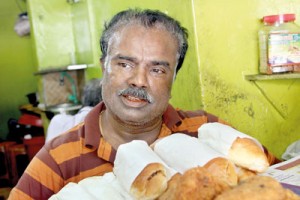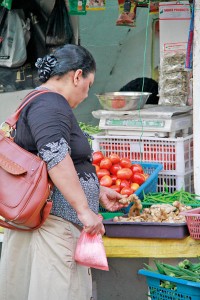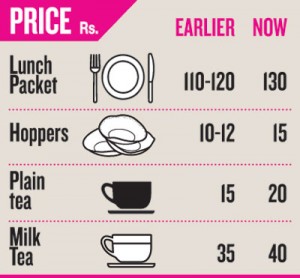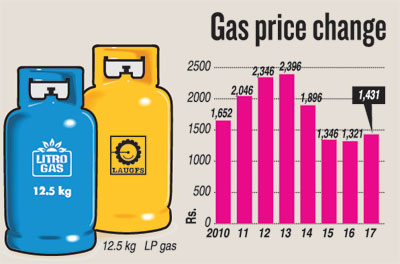News
Cooking gas duopoly puts housewives, restaurants on the burner
View(s):
T.M.Muneer
Homemakers are incensed at the increase in the price of cooking gas and so are the commercial users.

Nimal Kulasekara :Roadside restaurant operator said he will increase his prices, though not immediately.
A 12.5 kilogram Litro gas cylinder would cost Rs 1,431 in Colombo, up by Rs 110 from this week. The same applies to a Laugfs gas cylinder.
The Consumer Affairs Authority, took the decision in favour of the bottom line of dominant liquified petroleum gas suppliers.
Households will have to bear an additional financial burden and cut down on the use of cooking gas.
Some restaurant operators say they will not increase prices despite the extra cost to their operations.
Some admit the price increase is an added cost, but others are concerned that they could drive away diners if prices are jacked up.
Still, an industry group has announced price increases for tea, hoppers and lunch.

With price of gas also increased it's more burdens for the housewife. Pix by Priyantha Wickramaarachchi
Roadside restaurant operator, Mr Nimal Kulasekara, who has been in the business for 25 years in Slave Island, said he would increase prices, though not immediately. He said the cost of gas was not the only factor that will affect the prices of food and beverage.
His restaurant uses up one gas cylinder a day to make about 250 hoppers, 400 cups of milk tea and about 200 cups of black tea.
T. M .Muneer, who has operated a restaurant for seven years in Colombo, said he would not raise prices of meals, because that would drive diners away. But he noted, prices vary from one to restaurant to another. His restaurant uses up five gas cylinders a day.
“People are angry and worried at the same time. But we cannot afford to lose customers by increasing prices,’’ he said.
The chairman of the National Movement for Consumer Rights Protection, Ranjith Vithanage told the SundayTimes that LPG producers have been lobbying the Government to increase prices.
“The request was a long standing one that had been ignored until recently when they decided to increase prices considering global market price,’’ he said.
But he noted, prices are not reduced when prices in the global market drops.
“This price hike is another burden on many households,’’ he said.
Mr Vithanage said the group has asked the Government to negotiate and discuss with the LPG producers.
Meanwhile, with effect from last Thursday, the Association of Sri Lanka Restaurant Owners has decided to increase prices.
Milk tea will cost Rs 40, a Rs 5 increase and a hopper will cost Rs 15 compared with Rs 12 before. A cup of black tea will cost Rs 20, up from Rs 15. A packet of rice will cost Rs.130.
National organiser of the Association of Sri Lanka Restaurant Owners, Asela Sampath, suggested a price formula for food items.
He also said prices of food should be controlled.
Suhaila Hussain, president of the Housewives Association, said many are upset at the cooking gas price increase. “We appealed to all relevant authorities not to touch consumer items and instead increase taxes on luxury items. However the responses were negative,’’ she said.
| GAS USERS SQUEEZED FOR DUOPOLY’S PROFIT | |
| Sri Lankan homes are at the mercy of a powerful duopoly that controls the cooking gas market — Litro Gas and Laugfs.While a homemaker in Colombo will pay Rs 1,431 for a 12.5 kilogram gas cylinder, households in Badulla, Kandy, Jaffna, Trincomallee, Galle, for example will have to fork out a lot more. The two dominant companies Litro and Laugfs have an agreed price formula with the Consumer Affairs Authority to ensure profit margin for the sake of shareholders. Laugfs founder and chairman W K H Wegapitya complains in the annual filing that, “Price regulation was a key factor impacting profitability as the Consumer Affairs Authority failed to implement the agreed pricing formula for the retail price of LPG cylinders.’’ Margins declined by 7% compared to 18% in financial year 15/16, Laugfs says. The Employees Provident Fund has a 17% stake in the company. While two companies dominate Sri Lankan lives, until 1995, a state monopoly was operating in the form of Colombo Gas Company. Nearly 98% of Sri Lanka’s needs are imported and the two companies have seen their profit margins shrink. Both have been complaining about price regulation, rising prices in the world market, and about shrinking profit margins. Data from S&P Global Platts in Singapore show that prices of liquified petroleum gas hit a 10-month high at US$379.50 per metric tonne, while on August 28, Saudi Aramco set its September contract prices for propane at US$480 a tonne (up US$40 from July) and butane at US$500 a tonne (up US$60 from July) a new high since March. On January 4, it was US$385 per metric tonne. As a Board of Investment enterprise, Laugfs pays just 20% corporate tax. Many sweeteners have been granted to the company. Laugfs Gas generated Rs 10.38 billion in revenues for the year ended March 31, 2017. Group revenue was higher. The company booked a group loss of Rs 627 million on revenue of Rs 18.06 billion. Laugfs says it has more than 50,000 customers, 30 distributors and 5,000 dealers. Litro Gas claims to have a 72% market share it reached in 2015. |


